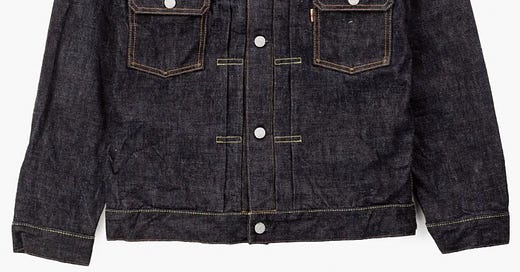How to capitalize on fandom
Modern brand power is in adopting fan behaviors and in treating its audience as fans.
Welcome to the Sociology of Business. For those new here, in my last analysis, How to operationalize your go-to-market strategy, I explored steps to follow to position your company in the market. Find my book The Business of Aspiration on Amazon and find me on Instagram, Twitter, and Threads.
David Beckham has a pair of bespoke jeans with five 18-carat gold buttons. They’ve been made by a Japanese denim Evisu in Kojima, a seaside town near Okayama.
Kojima is the spot of the first locally-made Japanese jeans (previously, there were only American imports in the country). The pioneering pair of Japanese jeans made of selvedge denim, Kurabo KD-8, was done by Big John (originally named Maruo Clothing) in 1972. M Series followed a year later. All denim was made locally, from the Okoyama prefecture-grown and woven cotton to the mills and cutting and sewing.
Fifty years later, Kojima is the Denim Disneyland. There are more than 200 denim companies - brands, mills, and wash houses - all fiercely competing with each other, spurring constant innovation and creativity. Thanks to this vibrant denim ecosystem, a steady stream of pilgrims, ranging from professionals to obsessives, flock to town.
Unpacked, Kojima ecosystem is made of denim brands, like Evisu, Momotarō, Kapital, Japan Blue Group. It is also peppered with local attractions, like jeans vending machines, selvedge road signs, and denim-blue ice cream. There are more than 40 premium denim stores along Kojima’s Jeans Street, surrounded selvedge mills supplying the world with any possible denim obsession: 14.5oz shadow selvedge, 8oz tapered, 17.5oz hank dyed, honeycomb fades, slub.
Artisanal, cutting-edge denim comes from years of honed local expertise, refined production techniques, and quality materials. It hasn’t always been this way. The mechanism that turned Kojima from a sewing base and a manufacturer of mass market denim into the refined and coveted selvedge dreamscape are the obsessive, innovative, creative denim fans who, over the years, congregated there.
Thanks to passion bordering on obsession, they keep the innovation alive and move the denim culture forward.
It’s no accident that the Denim Disneyland is in Japan. Otakus, once referring to hardcore anime fans, frequently feature in William Gibson novels as trendsetting cultural aficionados. With a good reason: Tokyo emerged as a global cultural lab during the economic book of the late 80’s bubble economy. Famously, Undercover, Pink House, or BAPE, dubbed as gathering spots for street artists, DJs, city pop clubbers, skaters, and zine makers. The brands themselves were the forerunners of future trends thanks to their mix of global influences filtered through their niche perspective.
Cultural obsessives play a central role in the modern aspirational economy. They create value - or, in case of Kojima, an entire industry - through the process of interpretation. Japanese denim brands’ original goal was not to create anything new, but to interpret imported American denim ideas, trends, styles and looks by making them slightly different than before. By doing so, Japanese denim fans put things out in the world that are experiments.
Though their interpretation, fans save brands from being outdated.
American prep has been preserved, reinterpreted, and reintroduced by its Japanese fans. New generations of Japanese fans gave American prep - like American denim - a fresh economic context and enhanced its value.
To access the rest of this analysis, choose one of the paid subscription options:
Keep reading with a 7-day free trial
Subscribe to The Sociology of Business to keep reading this post and get 7 days of free access to the full post archives.






